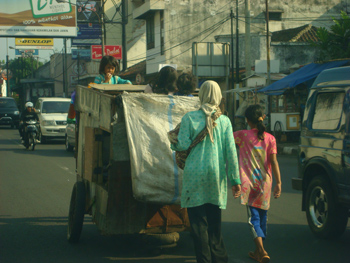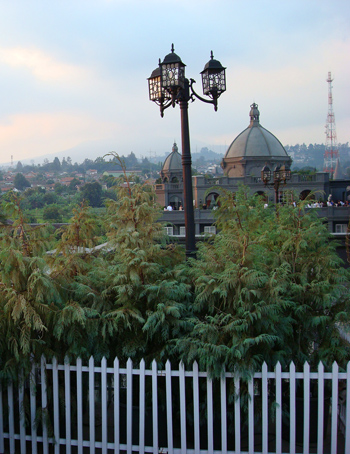Poor planning is undermining the historical significance of West Java’s capital
Adam Tyson
The view from Setiabudi atas, where visitors can still enjoy panoramic viewsAdam Tyson |
Bandung, the capital of West Java and the heartland of the Sundanese, is under pressure. Increases in the local population and poor planning have pushed the city to the brink. Bandung was once beautiful and orderly, famously described as the ‘Paris of Java’.
During the colonial period, Dutch officials would retreat from the chaos of Batavia to what architectural specialist Pauline van Roosmalen says was a ‘fresh and healthy mountain village’. Colonial planning paid particular attention to aesthetics, designing a spacious city of wide avenues lavished with greenery. Many of the city’s enduring landmarks were built in the 1920s, including the provincial parliament building, Gedung Sate, and the main campus of Indonesia’s renowned Bandung Institute of Technology.
Many of Bandung’s middle class are nostalgic for the colonial era. Despite the problems of the New Order period, they are also in mourning for Suharto’s planning initiatives. Nationally, the New Order government was heavy handed in its approach to population control and family planning campaigns strongly encouraged families to limit themselves to just two children. Transmigration shifted population pressures away from Java and towards the outer islands. Within Bandung itself the poor were kept off the streets, often violently, keeping poverty out of sight. Street vendors were banned in popular areas such as Jalan Dago – where hawkers now dominate every available space – ensuring that Bandung remained accessible to pedestrians and tourists. Since this time, Bandung has evolved into a sprawling metropolitan area of nearly three million inhabitants, battling problems of urbanisation and under-regulated construction – problems for which city planners and civil society actors are now proposing very different solutions.
Bandung in disarray
Bandung’s infrastructure is crumbling and city planning is in disarray. Greater Bandung is saturated by mega-developments, and commercial properties and factory outlets encroach upon heritage sites and cultural destinations. Poor planning has led to crippling traffic, piles of rubbish and flash floods. Jalan Pasteur used to be the ‘Beverly Hills’ of Bandung, sunny and lined with palm trees. Now it is a grotty overpass providing a pungent shelter for beggars and peddlers. Apart from a few isolated areas of greenery, the region surrounding Gedung Sate has been subsumed by commercial development.
The city is also increasingly under pressure from urban migration, with ever-increasing numbers of migrants from outside the city sparking ethnic tension between newcomers and locals. Disparaging comments about migrants from Sumatra, particularly Bataks and Minangkabaus, are commonly heard in the Dalem Kaum market on the eponymous street near the centre of Bandung. People from these regions are described as unruly and having little regard for the urban environment. Local Chinese and Sundanese are worried by the increasing visibility of these migrants and claim that it is these new residents of Bandung who are choking the narrow streets.
The latest government proposal to combat over-crowding is to return people to their hometowns with the offer of some financial incentive to cover relocation costs. So far this only applies to citizens of West Java residing in Bandung, but the scheme may be extended to migrants from other islands in the future. The government is also instigating a neighbourhood improvement scheme to try and discourage villagers from moving in the first place.
 |
A poor family collecting discarded plastic on Jalan Pasirkaliki Adam Tyson |
But while these initiatives demonstrate that the government is making some attempt to plan for Bandung’s future, the organisations responsible for planning are complicated and inefficient. City regulators in the Environmental Impact Management Agency (Bapedalda) are well versed in codes and ordinances, but high levels of official discretion mean that requirements are often not enforced. There are also clashes of interest between the Environmental Impact Management Agency and the regional branch of the National Development Planning Agency (Bappenas), which is charged with advancing economic growth. Currently there is no integration between these two organisations, a situation that often leads to conflict between official environmental and planning objectives.
At the same time non-government organisations are trying to bridge another gap, the discrepancy between official planning agendas and community interests. The Bandung Institute of Technology organises research groups that bring together a variety of experts to propose solutions to local planning problems. Key areas of research include transportation networks, architecture and interactive land-use models. Akatiga, an NGO that focuses on social analysis, has also become involved in research about planning problems. Having demonstrated that urban centres in Java have become ‘dumping grounds’ for surplus population and unprotected low-wage labourers, Akatiga encourages local government agencies to adopt participatory planning methods, which bring citizens into the planning process, as a way of managing these social issues.
Remaining treasures
Despite the problems associated with planning, a few important historical venues remain physically intact. The Dutch-style Rumah Musik Harry Roesli on Jalan Supratman remains open to the public and offers musical and dance tuition. Harry, the grandson of the prominent literary figure Marah Roesli, was an avant-garde musician and social critic who constantly strove to promote Sundanese music and art. The house runs a social program and many orphans and street children are given the opportunity to take musical lessons.
In the east of Bandung is the Saung Angklung Mang Udjo on Jalan Padasuka, another historical building which remains a venue for traditional Sundanese arts and music. The building has magnificent views of mountainous and terraced landscapes, although these are increasingly encroached upon by housing developments. Saung Angklung Mang Udjo remains well-maintained and provides a bamboo orchestra tuning service, training and performances.
These historical treasures have remained intact independent of government protection. But without better organised and implemented planning, Bandung’s historic remnants – and the orderliness of the city itself – may soon be lost. Government planners would benefit from paying greater attention to the suggestions of university researchers and NGO activists, whose ideas may be able to reinvigorate their tired agencies. There must also be greater coordination between government agencies if the competing imperatives of economic development and urban and environmental preservation are to be reconciled. Given the increasingly vocal role of civil society actors and their many innovative planning suggestions, there is still hope that that a cooperative, community-oriented solution to Bandung’s planning problems will be implemented before Bandung is irrevocably broken.
Adam Tyson (ipi2at@yahoo.co.uk) is a Visiting Lecturer at the College of Law, Government and International Studies in Universiti Utara Malaysia, where he is the Deputy Director of the Centre for International Affairs and Cooperation.



